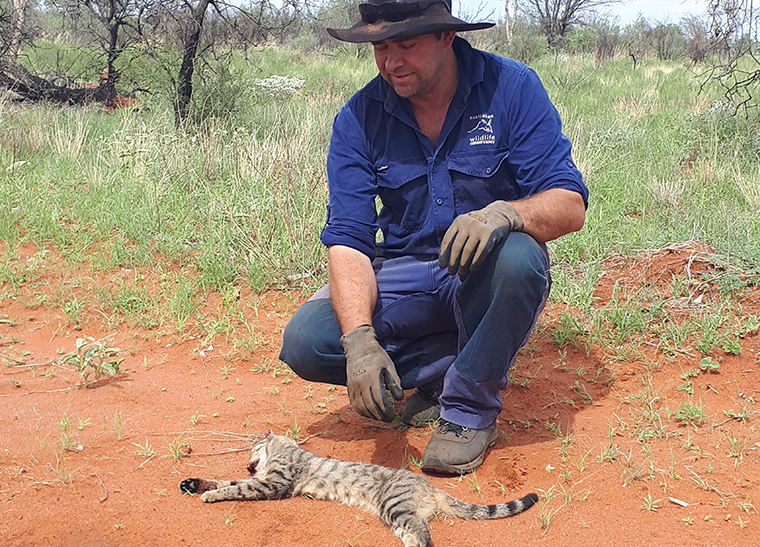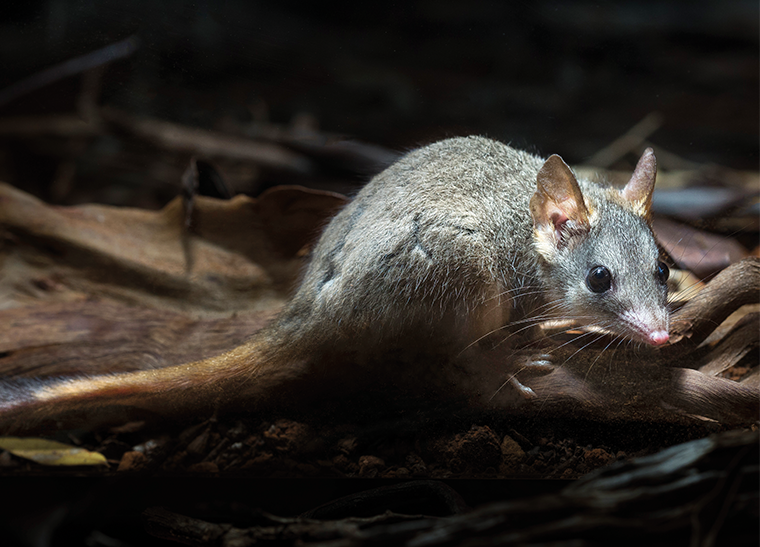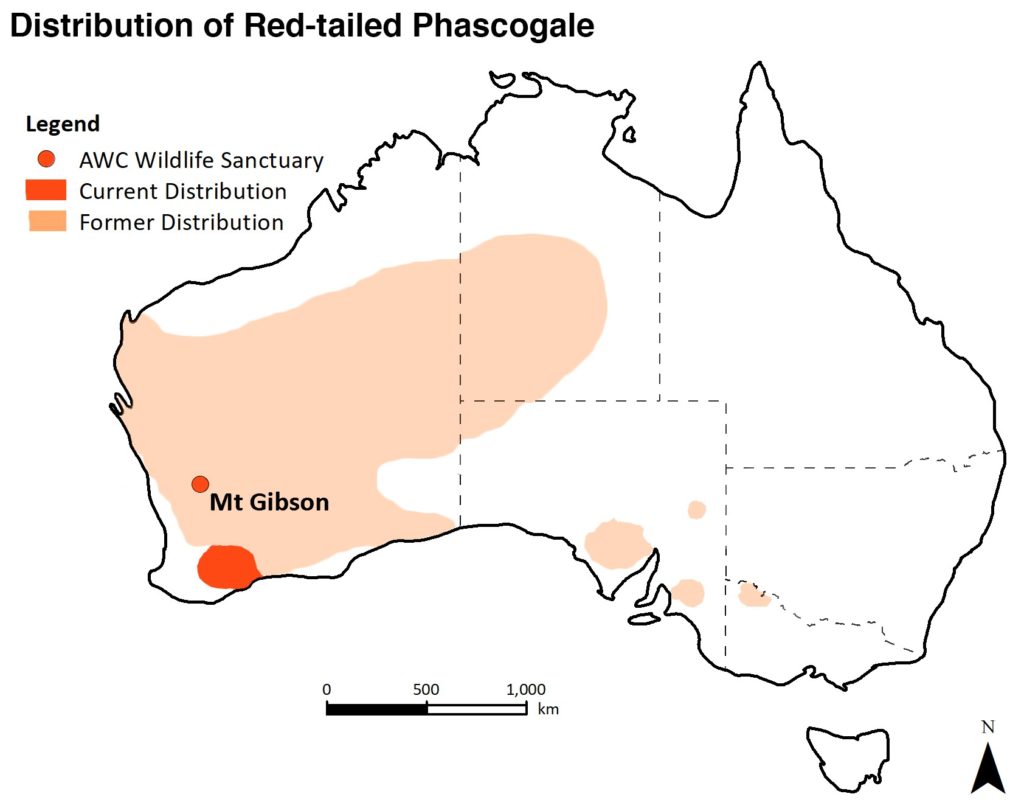By Dr Danae Moore, Wildlife Ecologist, Dr Rachael Collett, Wildlife Ecologist, and Josef Schofield, Newhaven Wildlife Sanctuary Manager
AWC’s landmark project to restore threatened mammals at Newhaven Wildlife Sanctuary has reached a milestone, with the eradication of all feral predators from the Stage 1 fenced area. This major accomplishment paves the way for the first mammal reintroductions, scheduled to commence later in 2019.
It has taken a lot of work to get to this point. In March 2018, the main gate to the 9,400 hectare feral-proof area at Newhaven was closed, marking the completion of construction work on the 44 kilometre, feral predator-proof fence. At over 1.8 metres high – and consisting of 9,000 posts, 18,000 support rods and 135 kilometres of wire netting – this fence is a major piece of Australia’s conservation infrastructure.
Next came the formidable task of eradicating feral animals – including feral cats, foxes and rabbits – from within the fenced area. The scale of the job called for an expert on-ground team, who between them brought a wealth of diverse trapping and tracking experience. Starting two months before construction on the fence was completed, our two professional feral animal control officers, Murray Schofield and Liam Orrock, worked in tandem with AWC’s Newhaven Warlpiri Rangers – Christine Ellis, Alice Henwood and Benedict Mosquito – to clear the Stage 1 area of feral cats.
 © David Fraser/AWC
© David Fraser/AWC
Benedict, Christine and Alice are exceptional trackers with decades of experience tracking cats in Newhaven and the surrounding region. Their approach is to follow fresh tracks, continuing their pursuit in some instances for many hours, until the cat tires and can be caught. Murray and Liam used complementary techniques, carefully setting soft-jaw and cage traps, and laying baits. Their efforts were strategically targeted, informed by the rangers’ tracking work. Alice, Christine and Benedict were able to build up a picture of individual cat movements and patterns of behavior, and this information was supplemented by a vast array of motion-sensor camera traps.
As the eradication progressed, this unique combination of skills was used to pinpoint the remaining cats. They worked consistently for 314 days and finally, on 4 December 2018, the last feral cat was caught: a female weighing more than two kilograms.
It was a remarkably effective operation which made use of traditional hunting techniques and the latest technology. Less than 12 months after the fence was completed, this mammoth undertaking has now created mainland Australia’s largest feral predator-proof area.
January 2019 marked the beginning of an intensive monitoring period, designed to confirm the feral- free status of the Stage 1 area. Over the four months since, 100 kilometres of tracking on four consecutive mornings every two weeks has been conducted. Additionally, data from 139 infrared cameras has been collected and analysed.
Intensive monitoring has shown no sign of any cats remaining within Stage 1 for several months, enabling us to declare the area feral predator-free.
At 9,400 hectares, Newhaven is now the largest feral predator-free area on mainland Australia.
AWC manages more cat and fox-free land on mainland Australia than any other organisation. This includes Scotia Wildlife Sanctuary, which until now, at 8,000 hectares, held the title of being the largest cat and fox-free area on mainland Australia. With Newhaven declared feral predator-free, AWC is now working on an ambitious program to restore at least 10 threatened mammals that have been lost to central Australia back to Newhaven.
Three species are proposed for reintroduction to Newhaven in 2019 – Mala, Red-tailed Phascogale and Numbat. Mala are extinct outside fenced areas on the mainland, while both Red-tailed Phascogale and Numbat have been lost from more than 99 percent of their historic range and have completely disappeared from the Northern Territory.
 © Brad Leue/AWC
© Brad Leue/AWC
A small population of Mala has already been established at Newhaven (within a smaller, purpose-built 150-hectare fenced area), following an emergency translocation from Watarrka in late 2017. This population was supplemented in 2018 with animals from an insurance population maintained at AWC’s Scotia Wildlife Sanctuary. AWC plans to transfer the remaining Mala from Scotia in 2019, if conditions on Newhaven are considered adequate to support translocating animals (like much of Australia, the sanctuary is currently experiencing a drought).
Red-tailed Phascogales are a small, insectivorous partly arboreal marsupial that once occurred throughout most of arid and semi-arid Australia, including the deserts of Central Australia. Predation by feral cats and foxes, combined with loss of habitat, caused the species to contract to a few remnant woodlands in the West Australian wheatbelt.
AWC has conducted a series of successful translocations of Red-tailed Phascogales to Mt Gibson Wildlife Sanctuary in Western Australia, where the reintroduced population is becoming established. In May 2019, AWC ecologists translocated 20 Red-tailed Phascogales from wild populations in the WA wheatbelt to Mt Gibson.
Another 20 phascogales were flown to Alice Springs, in the Northern Territory, to supplement a captive breeding program at Alice Springs Desert Park. The captive population will ultimately become a source for reintroductions into Newhaven when conditions are suitable.
Phascogales will be released into woodland habitat within the Stage 1 fenced area, in an area containing old, hollow-bearing bloodwoods. Across central Australia, many of these old trees have been lost due to changed fire regimes. The phascogales will also be provided with nest-boxes, to increase the number of available nesting sites and facilitate post-release monitoring.

AWC’s current and upcoming work with the Red-tailed Phascogale represents a collaborative effort towards the conservation of the species, and involves the West Australian Government, New South Wales Government (through our work at Mallee Cliffs National Park), Alice Springs Desert Park, and Zoos South Australia. As well as providing phascogales for the reintroduction project at Newhaven, animals from the captive breeding program may be used to further supplement Mt Gibson’s Red-tailed Phascogale population; and to contribute to a second captive breeding program at Monarto Zoo, to help establish a population at Mallee Cliffs National Park in New South Wales.
The third species scheduled for reintroduction to Newhaven in 2019 is the Numbat. AWC already protects 50 per cent of the total population of this nationally endangered species within our existing network of predator-free havens.
Newhaven represents the northern known limit of the Numbat’s historical distribution, prior to the decimation wrought by feral predators. Numbats would be sourced initially from the captive population at Perth Zoo and from wild animals at AWC’s Scotia Wildlife Sanctuary. Rigorous monitoring following the translocation will track survival, home range and habitat preferences of Numbats in this arid environment.
Reaching this important milestone means AWC is on track to restore some of Australia’s most threatened mammals to central Australia. With the first translocations kicking off this year, Newhaven will soon be home to a diversity and abundance of wildlife approaching that which existed prior to the arrival of Europeans. As reintroductions into Stage 1 proceeds, AWC is beginning initial planning for Stage 2. Projected to encompass a massive 100,000 hectares, this ambitious project will be the largest feral cat eradication on the planet and is ultimately expected to see the populations of at least five threatened Australian animal species doubled.
Newhaven Feral Animal Eradication Report Card
Effort
• 5,338 soft-jaw trap nights
• 100 hours spent tracking cats
• 154 kilometres walked tracking cats
• 139 infra-red cameras deployed
• 10 x 1080 meat baits laid for foxes
• 120 kilograms of 1080 baited oats laid for rabbits
Results
• 46 cats removed
• All rabbits eradicated
• 2 foxes removed
• 9,400 hectares declared feral predator-free